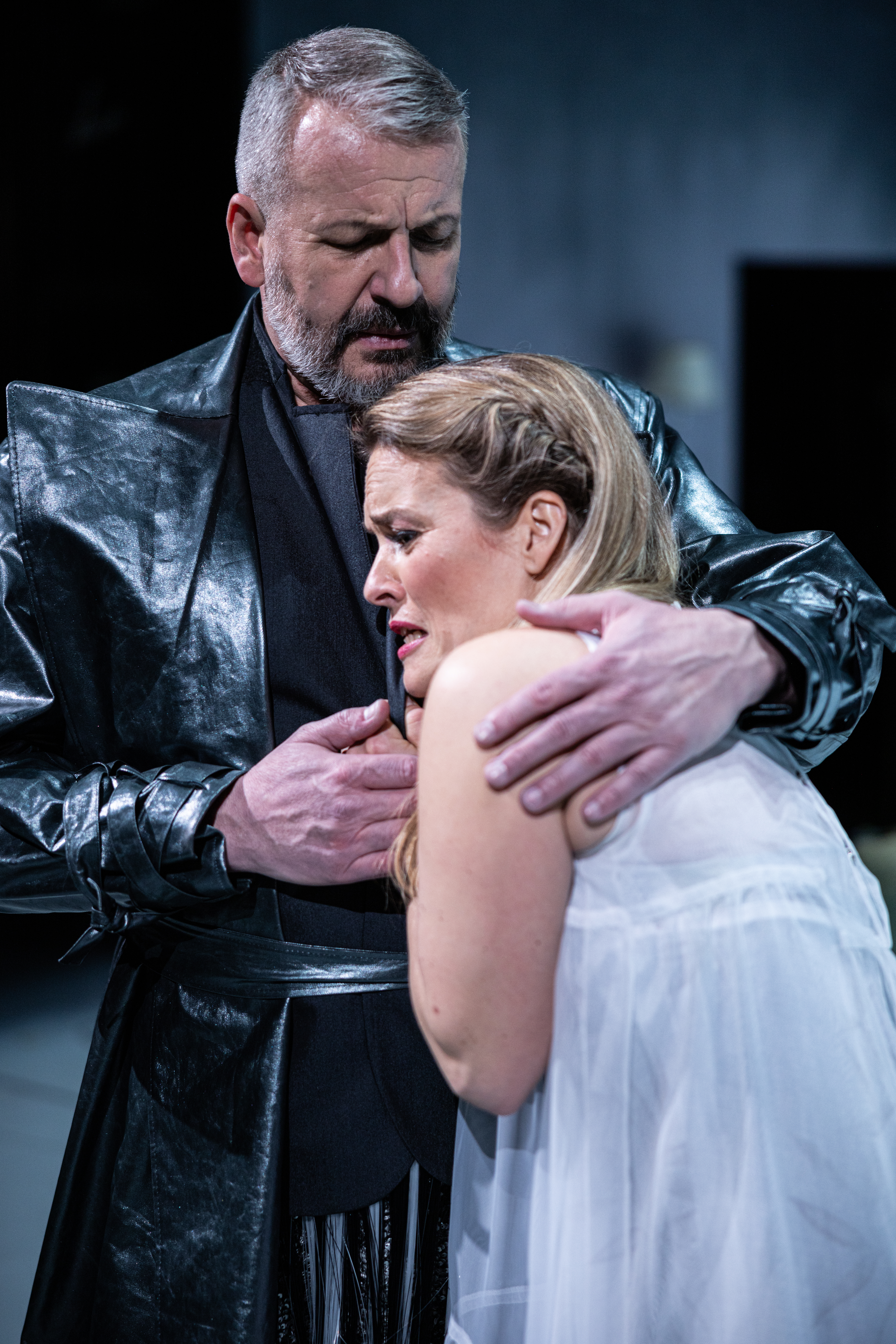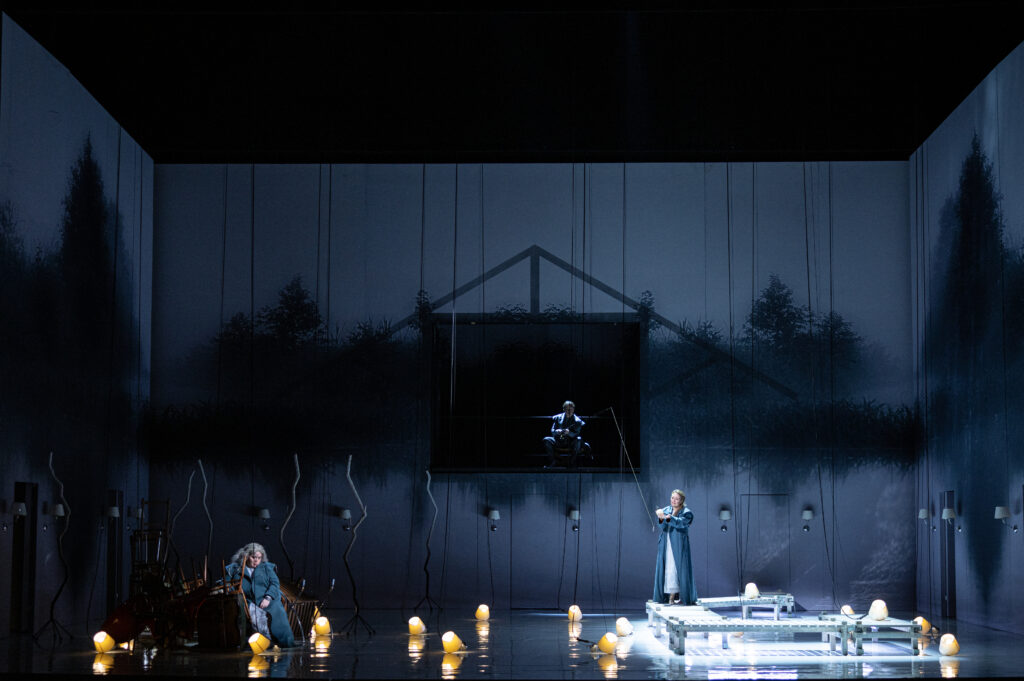The National Theatre is presenting a new production of “Rusalka” in the fish pond, while the “Prodaná nevěsta” is in its third year as a play with cultural appropriations.
This year marks the 200th anniversary of Bedřich Smetana’s birth, but since 1924, the Czech Republic has celebrated a Year of Czech Music every ten years to mark the occasion. Reason enough to celebrate a national festival involving various institutions with a “four” at the end every year since then, with a series of concerts and performances commemorating the search for a Czech identity in the spirit of music.
This year, contemporary and foreign music will be included for the first time with the “Opera Nova Festival” in June. However, the centrepiece will of course remain the treatment and performance of the Czech pillars and foundations, the music of Smetana and Antonín Dvořák, the 120th anniversary of whose death will also be celebrated in May 2024.
Both giants of music dominate the repertoire of the National Theatre and the State Opera in Prague – and rightly so, of course. Testimony to the immense impact of both world-class composers is the unbroken audience response at the “Národní divadlo”, the National Theatre on the banks of the Vltava River, where Dvořák’s “Rusalka” premiered in 1901. Smetana’s “Prodaná nevěsta” (The Bartered Bride) had already seen the light of day in the interim theatre on the same site in 1866.
An hour before the start of the 8th performance of the 14th production of “Rusalka”, as the programme says, queues form in front of the ticket office with the sign “sold out”. And this despite the fact that another production (with an almost identical cast!) has been running at the Státní opera, the state opera house on the edge of Prague’s main railway station, since 2005. The day before, the repertoire performance of “Prodaná nevěsta” was also very well filled except for a few seats, and that in the middle of the week.
Allice Nellis, born in Budweis, is responsible for a “Bartered Bride” in a production from the year 2022, which transfers the folkloristic down-to-earth nature of the work with its dances and (folk) melodies into the present day and also plays a tongue-in-cheek game with cultural appropriation. It’s fun and thought-provoking. Not only the Czech suburbs, but also the banlieue suburbs and satellite towns of this world are socially mixed melting pots in which subculture is created and lived. And at some point, these subcultures will also be adopted by high and mainstream culture, developing a wide reach and captivating the masses. It was similar in Smetana’s time: “Prodaná nevěsta” is set in rural Bohemia, in the countryside and in the world of peasants and ordinary people. Where matchmaking and traditional rites are practised and prevail unquestioningly.
The symbol and expression of this milieu – today as then – is expressed in the music. Then as now, the feeling of the times is conveyed by the melodies that are carried into the world. Rap is nothing other than the Bohemian folk tunes. And Allice Nellis demonstrates this impressively in a setting designed by Matěj Cibulka in the middle of the concrete rows of tower blocks in the social hotspots of the suburbs. There is rapping and partying. In Klára Lidová‘s ballet choreography, the residents drink and dance between the facades of houses and vegetable crates. A colourful string of light bulbs provides some cosy warmth, and the illuminated walls (video art design by Michal Mocňák) also exude the good and beautiful microcosm of diversity.

And this is where the game of appropriation begins: Rap or folk music, born out of the spirit of certain lifestyles and original attitudes, have thus themselves fallen prey to appropriation in a new form compatible with mainstream and operatic high culture. Whether this is good or bad remains to be seen.
Richard Samek‘s Jeník is a veritable, versatile opera singer with a good dose of Italianità, the only character in the piece to be cast and cast right at the beginning. As a directorial idea, the production is still open at the beginning. A director-statistician (Martin Kubačák), who is developing the production over the course of the acts, has invited auditions. They are looking for a Mařenka for the set Jenik star. Throughout the performance, the role is therefore played by two female singers, which develops into an interesting interplay of roles between youthful lightness and knowing, mature drama, in which neither of them (the one role) wins in the end. Although Mařenka 1 (played by Jana Sibera with acting fulminance and great, versatile expressiveness) falls from the boxes of the suburbs in the meantime and is initially replaced by Mařenka 2 (Doubravka Součková in harsh lyricism), both ultimately share the role.
Richard Samek demonstrates Jenik’s versatility and his desire for an applause-inducing effect beautifully with a constantly accompanying photographer. In the suburban ghetto with flowing Rasta hair, he poses smoking pot in front of the “No war” graffiti on the wall of the building. Where temporary symbols of resistance have solidified into rituals: “No war”, Rasta and joints – the circus at the beginning of the third act is also tongue-in-cheek. Beer-drinking white indigenous people, like something out of a Karl May film, perform a dance choreography with white monkeys bathed in glistening light.

Although this does not break the immanent national colouring of the original work, it does put it into perspective and softens it. Josef Moravec‘s interpretation of Vašek is particularly impressive, as a wonderfully clear-voiced stutterer with precise phrases who knows how to create a transparent and elegant interpretation. Jiří Sulženko‘s Kecal also brings some musical brilliance to the evening with his healthy bass depth and beautiful sound.
The regular repertoire with daily performances shows what can be an advantage, especially with regard to choirs and orchestra. On both performance days, the choir (conducted by Lukáš Kozubík) and orchestra performed with an independent expressiveness and plasticity, as if there was and was no need for further artistic interpretation and guidance for a particular interpretation. Rather, the ensemble seems to have internalised the work and music to such an extent that it needs little more than commitment and timing to offer the audience a pulsating and situational work of art. The choir offers an all-round convincing and atmospherically gripping performance, from radiant, unified power to graduated vocal diversity. This is particularly true of the orchestra: David Švec does not need to exert any great moderating or driving influence on his musicians in either performance. Instead, the natural progression of the works – between an earthy, brownish overture to The Bartered Bride and a precisely nuanced introduction to Rusalka – gives rise to dynamics developed by the orchestra itself, dramatic pull (in Rusalka) and a light, snappy but virile melodic line (in Prodaná nevěsta). The consequence of this approach, however, is that there are repeated problems of coordination between the pit and the stage, which could have been avoided by clearer direction from the podium and more interaction than a grand gesture that ends up as a solitary act.
The ballet presents itself as a permanent fixture and the indispensable backbone of both productions with extremely finely choreographed scenes, which are danced in various incarnations by the inhabitants of Rusalka’s fish pond.

Rusalka has not been performed at the National Theatre for almost a year. The new production in the style of SKUTR presents itself as a highly symbolically charged interpretation of the Urslavic saga with a mythological world of experience based on a natural fishpond microcosm. SKUTR – an allusion to “Scooter” – is, by its own account, a “tandem of the performing arts” and is associated with the names Martin Kukučka and Lukáš Trpišovský.
The space-filling natural pond with a central fishing hut in the background (set design by Martin Chocholoušek) is the centrepiece of a tragedy of relationships between male-woman and man-fish, which constantly changes meaning through variable water levels and the profound interplay of stage elements such as lamps, which are also fishing poses as will-o’-the-wisps, which are also emphasised by the constantly changing height of the water level.

Right at the beginning, the prince is fishing and the mermaid Rusalka shows interest. By the time she has taken the bait, it is already too late and the tragedy takes its course. Alžběta Poláčková acts and sings a Rusalka of dramatic depth and convinced love, who scores in the big, desperate outbursts but also knows how to delicately shape the tender pianos.
Aleš Briscein plays a prince who appears to be a fisherman who doesn’t like eating fish. He is only driven by a hunting instinct in search of the unknown. His tenor is therefore not inappropriately pale, resigned and strained in the high notes, as if constricted by the weight of instinct. These are short-lived desires, which he seeks to satisfy soon after Rusalka through the Princess (Ester Pavlů with a radiant, expansive mezzo). Satisfying instincts is written in capital letters in the new production, but with discreet and restrained means.
The fat carps at the bottom of the lake provide a musical highlight with Anna Moriová (Kuchtik – Kitchen Boy) with a sparkling, flowing mezzo and Jiří Hájek (Hajný – Hunter) with a meltingly clear baritone, while Jana Sýkorová‘s Ježibaba with flickering intonation fell far short of the quality of the otherwise well-balanced cast.
František Zahradníček‘s Water goblin (Vodník) was convincing with a clearly intoning bass-baritone, albeit with indifferent transitions in some passages.
The “Opera Nova Festival” takes place from 14 to 22 June. “Prodaná nevěsta” on 12 June, 28 August, 10, 19, 28 September and 16 October. “Rusalka” at the National Theatre again on 2, 15 June, 21, 27 September and 11 October.